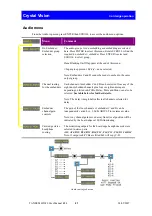
Crystal Vision
Using the front control panel
TANDEM HD-20 User Manual R1.4
32
24/05/2007
Menu
Comment
Audio routing to
output embedders
The audio channel routing for embedding onto the output video is
selected here. Press F2 to select this menu. Rotate SCROLL to
find the embedder channel to be routed. F1-4 give further options.
Embedder C
channel selection
Press F1 to set routing. SCROLL to select.
A1-4, B1-4, R1-4, F1-4 > C1 etc.
Press F2 to select Audio delay. SCROLL to select.
On, Off.
Press F3 to select Mute. SCROLL to select.
On, Off.
Press F4 to select Mono conversion. SCROLL to select.
On, Off.
Embedder D
channel selection
Press F1 to set routing. SCROLL to select.
A1-4, B1-4, R1-4, F1-4 > D1 etc.
Press F2 to select Audio delay. SCROLL to select.
On, Off.
Press F3 to select Mute. SCROLL to select.
On, Off.
Press F4 to select Mono conversion. SCROLL to select.
On, Off.
Audio Delay
This control can be used to delay the audio with respect to the
video by up to 64ms and compensate for any small delay between
the incoming video and audio signals. The delay is applied at the
output of the 16x8 router and is a single global control.
0-64ms.
Stereo to Mono conversion
For the purposes of this discussion it is assumed that all inputs are stereo pairs and that each
half of the stereo pair is on a consecutive input i.e. input 1 and input 2 are a stereo pair, input 3
and input 4 are a stereo pair etc.
The action of converting a stereo pair to a mono output is simply a summing process followed
by a gain correction. The gain correction is necessary because when the two components of a
stereo signal are summed a 6dB increase in output level will result; this will then need to be
corrected to maintain unity gain.
The action of selecting will cause that channel to output the mono sum of itself and its
associated channel. The associated channel output will still output its unaltered programme.
Either channel of a pair can be selected for stereo to mono conversion.






























